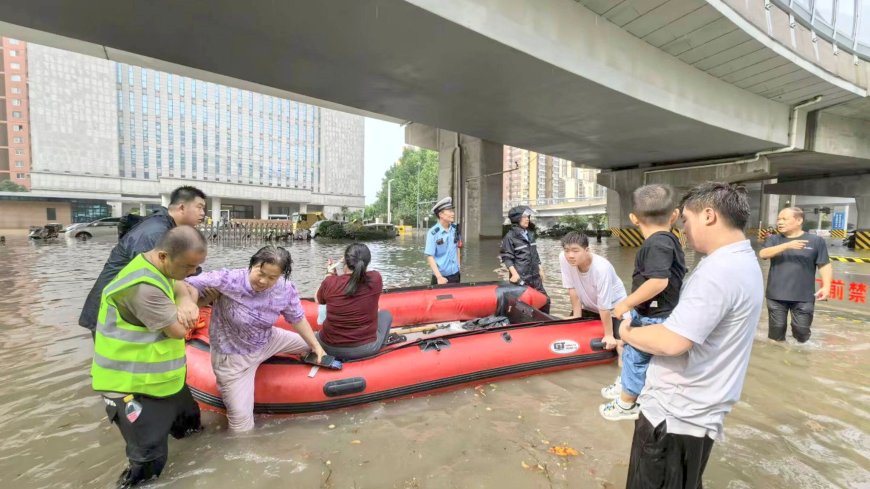When Half a Year’s Rain Falls in a Day: Flash Floods Ravage Gansu’s Yuzhong County
Severe flash floods in Yuzhong County, Gansu Province, China, have killed at least 10 people and left 33 missing after record rainfall in just 24 hours. Rescue operations are underway as President Xi orders an “all-out” response.

When Half a Year’s Rain Falls in a Day: Flash Floods Ravage Gansu’s Yuzhong County
On August 7 and 8, 2025, Yuzhong County in China’s northwestern Gansu Province experienced a catastrophic meteorological event—nearly half a year’s worth of rainfall in under 24 hours. Torrential downpours triggered deadly flash floods and a landslide, leaving at least 10 people dead and 33 missing. The disaster has devastated remote mountain communities and prompted urgent nationwide rescue efforts.
A Sudden Deluge in the Loess Plateau
Meteorological authorities report that rainfall reached approximately 195 mm (7.7 inches) in the affected area by early August 8 AP NewsReutersThe Watchers. To put that in perspective, Yuzhong County typically receives between 300 and 400 mm over an entire year, meaning that much of the annual precipitation fell in just a few hours ReutersThe Watchers.
This intense deluge occurred across the Loess Plateau, an area known for its loose, silt-rich soil structure. Saturated, this terrain is highly prone to landslides and flash flooding, with the newly awakened torrents carving paths of destruction through communities ReutersThe Watchers.
Human Cost and Infrastructure Collapse
According to state media and the Associated Press, at least 10 people lost their lives, and 33 remain unaccounted for following the flash floods AP News+1Al Jazeera. A landslide in Maliantan village contributed further to the human toll, leaving an additional three people missing AP NewsThe Indian Express.
The floods knocked out power and telecommunications across several villages in the Xinglong Mountain area—stranding more than 4,000 residents in four isolated communities AP News+1The Watchers.
Government Response: Rescue and Recovery
Reacting swiftly, President Xi Jinping ordered an "all-out" rescue operation. His directives emphasized rescuing the missing, relocating at-risk residents, and restoring essential services as quickly as possible. He also cautioned against complacency, noting the growing frequency of extreme weather events ReutersAP NewsGB Code.
The National Development and Reform Commission has allocated 100 million yuan (about USD 14 million) to support Gansu’s rescue and relief efforts Reuters.
Climate Context: Extreme Weather on the Rise
This disaster comes amidst a string of severe weather events across China. In recent weeks, record rainfall and flooding have impacted northern and southern regions alike, including deadly incidents in Beijing ReutersAP News.
Experts cite climate change as a driving factor behind such increasingly extreme and unpredictable weather patterns, which raise the urgency of improving early warning systems, preparing disaster response infrastructure, and reinforcing vulnerable communities ReutersAP News.
Why Yuzhong County Was Uniquely Vulnerable
Several factors compounded the disaster’s impact:
-
Geological makeup: The Loess Plateau's loose soil structure destabilizes quickly when saturated, intensifying flash flood and landslide risks ReutersThe Watchers.
-
Rapid onset: With rainfall peaking in just one day, residents had little to no warning—a hallmark of flash floods WikipediaThe Watchers.
-
Rural infrastructure: Remote villages in mountainous terrain, reliant on limited power, communications, and access, were disproportionately affected.
Voices from the Ground
Though direct eyewitness reporting remains limited due to disrupted communications, social media and weather analysts provide glimpses of the reality:
“Yuzhong County … received 220 mm of rainfall in the past 24 hours. Severe mountain torrents broke into villages… causing 10 deaths and 33 people missing. Rescue work is still underway.” The Watchers
Local on-the-ground images—shared via CCTV and local government channels—show roads slick with silt, uprooted trees, and rescue personnel wading through ankle-high water and rushing currents ReutersAl JazeeraThe Watchers.
Outlook: Rebuilding and Preparedness
In the immediate aftermath, search and rescue remain the priority—recovering missing persons, tending to the injured, and transporting food, clean water, and medical supplies to stranded communities.
Longer term, Gansu and similar regions will need to invest in:
-
Enhanced early warning systems,
-
Strengthened transport and communications infrastructure in remote areas,
-
Flood-resistant urban planning, and
-
Community education on rapid evacuation during flash flood warnings.
These steps can reduce future casualties and improve resilience in the face of increasingly severe weather.
Conclusion
The flash floods that struck Gansu’s Yuzhong County over August 7–8, 2025, were catastrophic—not only for the immediate human toll, but also as a stark illustration of the vulnerabilities inherent in rural, mountainous regions facing accelerating climate extremes.
But amid tragedy, there's resolve. With strong leadership and sustained investment in preparedness, affected communities can recover—and stand better defended against the storms yet to come.











